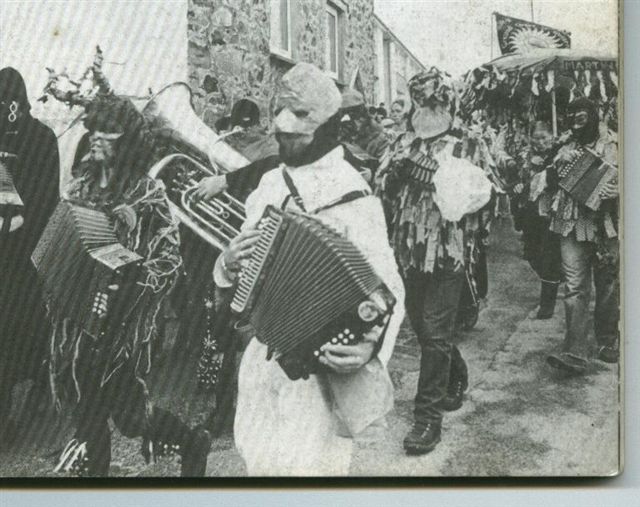
Back - Forward - Main Index
St Ives Guise Dance

Turkey
Rhubarb, Turkey Rhubarb, Turkey Rhubarb I sell
I come here from Turkey to make you all well
Don't you all know me, oh me name it is Dan
For I am the celebrated Turkey Rhubarb man
Up
until the early 1900’s the period between Christmas Day and Twelfth Night was
still celebrated in West Cornwall with Guise Dancing. During this season the
streets of St. Ives and the villages around Newlyn and Penzance were nightly
paraded by parties of young people attired in strange costumes. In most cases
the boys were dressed as girls and the girls as boys. Some of them cleverly
represent historical characters; others were merely disguised with blackened
faces and Nottingham lace veils, begged from their mother’s meagre supply of
old curtain hangings. Failing this they would mask up with scarves and bandanas
covering their faces almost completely.
These
'Goose or Geese-dancers' paraded the streets and often behaved in such an unruly
manner that woman and children were afraid to venture out. If the doors of the
houses were not locked they would enter uninvited and stay, playing all kinds of
antics, until food and drink and money was given them to go away.
They became such a terror to the respectable inhabitants of Penzance that the Corporation put a stop to the celebrations in about 1880. Every Christmas Eve notices were posted in conspicuous places in the town, forbidding the appearance of any dancers in the streets over the next 12 days, but they still kept up the tradition in St. Ives. Guise-dancing celebrations must have deteriorated in style since the beginning of the 19th century, as writers then spoke of a time when all enjoyed the merrymaking.
Robert Hunt in his "Popular Romances of the West of England" published in 1870, tells us that.......
"this (St Ives) is the only town in the country where the old Cornish Christmas revelry is kept up with spirit. The Guise dancing time is the twelve nights after Christmas. Guise dancing in St Ives is no more nor less than a pantomimic representation or bal masque on an extensive scale, the performers outnumbering the audience."
The
Turkey Rhubarb dance always formed the finale to the evenings proceedings before
the exhausted participants at last gave up and went home. This last dance was
associated with the Christmas Mummers play and a concertina, often referred to
as a `cordial`, provided the music. After
a lapse during the war years attempts were made to revive the custom and
in some places it made a comeback. The
dancers performed in heavy shoes fitted with scoots [metal pieces attached to
the soles]
The
BBC apparently recorded and broadcasted extracts from the Geese dancers
performance of Turkey Rhubarb in 1936 but there is no trace of it in the
archives made available to researchers. Miss Helena Charles, who set up a school
of inter-Celtic dancing in Cornwall in l949, provided further corroboration of
this dance as she was aware of it being used by Paul and Madron W.I. as part of
their Christmas Mummers play `St George and the Turkish Knight`
The
name `Turkey Rhubarb` is itself a delightful enigma. There might obviously be
some connection or confusion with the Turkish knight in the Mummers Christmas
play. However, Turkey Rhubarb was a Chinese herb ‘Rheum Palmatum’ -
NOT
the common garden rhubarb.
Apothecaries
used its root
as a cure for diarrhoea, but its use can cause intense
cramping.
Larger
doses were employed as
a
laxative.
Morton
Nance’s Cornish Dictionary gives ‘Tavol Turkey’ is an alternative Cornish
word for Rhubarb. Perhaps the antics of the dancers were akin to the cramps
effect on the body and someone made the
humorous [?] connection
The dance is in fact a form of mazurka, a polish peasant dance which spread
westwards across Europe during the late eighteenth century. It seems to be found
in most European dancing traditions and dancers in Champagne, Holland, Brittany
and Ireland have performed recognisable variants. By far the closest to the
Cornish is that done on the West coast of Ireland variously called Father
Murphy’s Topcoat or Patsy Heeny. Although this is as Irish in style as ours is
Cornish the two dances are almost interchangeable.
Turkey
Rhubarb, Turkey Rhubarb, Turkey Rhubarb I sell
I come here from Turkey to make you all well
Don't you all know me, oh me name it is Dan
For I am the celebrated Turkey Rhubarb man
Today
all that remains is one long night of conspicuous drinking and celebration in St
Ives on New Years Eve, as the revellers go from pub to pub, usually ending up on
the beach in front of “The Sloop” to welcome in the New Year. Most of those
who take part do dress-up in some kind of fancy dress attire but little takes
place in the way of dancing.
Doors to the cottages at Downalong these days, however, remain firmly locked. But that will not bother us as we join in the celebrations on the beach but first lets get into costume.
For more information on the Cornish music & dance go here